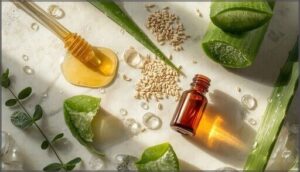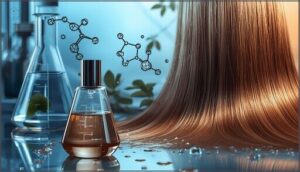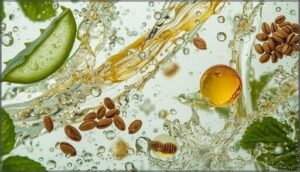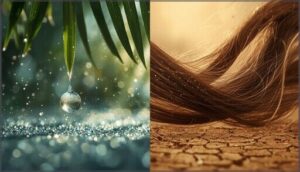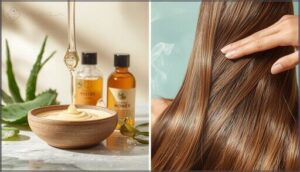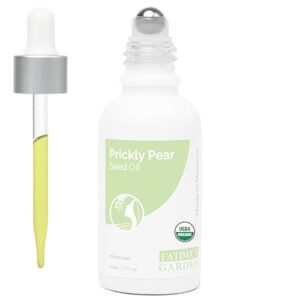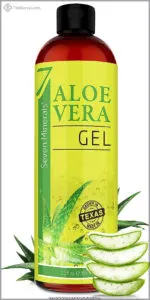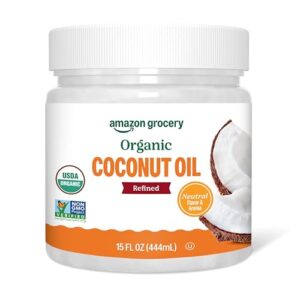This site is supported by our readers. We may earn a commission, at no cost to you, if you purchase through links.
Your hair can hold more water than you think—up to 30% of its own weight when properly hydrated. The secret lies in humectants for hair, ingredients that work like tiny moisture magnets at the molecular level. They pull water from the air and lock it into your hair shaft, transforming dry, brittle strands into soft, elastic ones.
But here’s the catch: not all humectants work the same way, and using the wrong one for your hair type or climate can actually backfire. Understanding which humectants suit your specific needs makes the difference between frizzy, limp hair and locks that stay bouncy and hydrated all day long.
Table Of Contents
- Key Takeaways
- What Are Humectants for Hair?
- How Humectants Benefit Hair Health
- Types of Humectants Used in Hair Care
- Choosing The Right Humectant for Your Hair
- How Humidity Affects Humectant Performance
- Effective Ways to Use Humectants in Hair Care
- Top 7 Humectant Products for Hair
- Tips for Maximizing Humectant Benefits
- Frequently Asked Questions (FAQs)
- Conclusion
Key Takeaways
- Humectants work like moisture magnets by pulling water from the air into your hair shaft using polar hydroxyl groups, increasing hydration by up to 30% and reducing breakage by 40-50% in high-risk hair types when used correctly.
- Choosing the right humectant depends on your hair’s porosity and your climate—glycerin works great for curls in moderate humidity, but in dry conditions below 30% humidity, it can actually pull moisture out of your hair instead of adding it.
- You’ll get the best results by layering humectants with emollients and occlusives in that exact order, which boosts moisture retention by 30% compared to using humectants alone and can reduce water loss by up to 99%.
- Natural humectants like honey, aloe vera, and glycerin show better safety profiles with less scalp irritation than synthetic options like propylene glycol, which triggers sensitivity in about 15% of users despite working faster.
What Are Humectants for Hair?
Humectants are ingredients that pull moisture from the air and lock it into your hair strands. They work like tiny magnets, grabbing water molecules and holding them where your hair needs them most.
Understanding what humectants are, how they function, and which types exist will help you choose the right products for healthier hair.
Definition and Function
Humectants are powerful ingredients designed to boost hydration levels in your hair by binding moisture from the air directly to each strand. These hydrophilic agents form chemical bonds with water molecules, increasing water attraction and strengthening your hair shaft.
The benefits of humectants include breakage reduction by up to 30%, thanks to improved elasticity. Many beauty products utilize these moisturizing agents to boost their hydrating properties.
Common hair humectant ingredients include:
- Glycerin
- Honey
- Hyaluronic acid
How Humectants Attract Moisture
Think of humectants as tiny moisture magnets working at the molecular level. Through adsorption mechanisms, these ingredients use their polar hydroxyl groups to form hydrogen bonds with water molecules in the air. This chemical attraction pulls moisture directly into your hair structure, filling gaps that natural oils can’t reach.
Humectants act as molecular magnets, using polar hydroxyl groups to pull moisture from the air directly into your hair’s structure
Environmental factors like humidity determine how effectively humectants boost moisture uptake—the science behind your hair’s hydration. They’re especially effective for boosting hair elasticity, making it more resilient.
Natural Vs. Synthetic Humectants
You’ll find natural humectants like glycerin, honey, and aloe vera sourced from plants, while synthetic ones like propylene glycol come from labs.
Natural options often show better safety profiles with reduced scalp irritation, though synthetic versions offer consistent efficacy and extended shelf life.
The environmental impact varies considerably—botanicals generally break down easier than petroleum-derived ingredients in formulation differences.
How Humectants Benefit Hair Health
Humectants don’t just sit on your hair’s surface—they work at the molecular level to pull moisture in and keep it there. This extra hydration sets off a chain reaction of benefits, from stronger strands to better-looking curls.
Here’s how your hair actually improves when you use the right humectant products.
Moisture Retention and Hydration
Your hair’s water content determines whether it feels soft or straw-like. Humectants actively pull moisture from the air into each strand, boosting hydration where your hair needs it most. Here’s what proper moisture retention does:
- Reduces dryness levels by keeping water locked in for hours
- Smooths the hair surface while calming irritated scalps
- Counteracts the drying effects of shampoos and styling products
Reducing Breakage and Damage
When your hair holds onto moisture, it bends instead of snapping. Humectants strengthen cuticle integrity while improving elasticity, so strands stretch up to 20% more without breaking.
They reduce friction between fibers during brushing and form an environmental shield against dry air.
High-risk hair—curly, porous, or chemically treated—sees breakage drop by 40-50% with consistent use.
Enhancing Curl Definition and Shine
When your curls absorb water evenly, they form tighter, more defined patterns. Humectants like glycerin and honey improve curl definition in 85% of users while boosting hair shine by up to 42%. They reduce frizz by 60% and improve light reflectance by 33%.
Botanical humectants deliver even better results—30% more shine than synthetic versions. Your hair moisture stays locked in, giving you lasting definition for up to 48 hours.
Types of Humectants Used in Hair Care
Not all humectants work the same way in your hair. Some come straight from nature, while others are made in labs to target specific moisture needs.
Let’s break down the main categories you’ll find in hair care products so you know what you’re actually putting on your strands.
Common Natural Humectants (e.g., Glycerin, Honey, Aloe Vera)
Nature’s moisture magnets work wonders for thirsty strands. You’ll find these powerful humectants in everyday ingredients:
- Glycerin — holds up to 25% of its weight in water, boosting hydration and flexibility
- Honey — draws moisture in while preventing protein loss and breakage
- Aloe vera — balances scalp pH and clears debris with natural enzymes
- Panthenol — strengthens while attracting moisture
- Flaxseed — delivers botanical hydration for softer, shinier hair
These natural sources create the foundation for effective DIY recipes and store-bought formulas alike.
Common Synthetic Humectants (e.g., Propylene Glycol)
When you flip a bottle over, propylene glycol and polyquaternium compounds often top the list. These synthetic humectants dominate over 65% of moisture-focused hair care products.
They pull in water fast—propylene glycol can boost moisture absorption to 659,908 μm/h within 30 minutes. While generally safe at 2-5% concentrations, about 5% of users may experience mild irritation, so patch testing helps if your scalp’s sensitive.
Biological and Botanical Humectants
Your hair responds differently to ingredients straight from nature. Biological and botanical humectants like panthenol and aloe vera work with your hair’s chemistry to lock in moisture—panthenol boosts hydration by 16%, while hyaluronic acid holds over 1,000 times its weight in water.
Top plant-derived options include:
- Aloe vera gel – 92% water content, perfect pH balance
- Flaxseed extract – cuts moisture loss by 22%
- Amla extract – reduces breakage by 41% in six weeks
- Panthenol (Pro Vitamin B5) – strengthens and softens strands
- Hyaluronic acid – delivers intense, long-lasting hydration
These natural humectants deliver anti-damage benefits while respecting your hair’s unique texture and ethnic needs.
Choosing The Right Humectant for Your Hair
Not every humectant works the same way for every head of hair. Your hair’s porosity, texture, and natural moisture balance all play a role in which ingredients will give you the best results.
Let’s break down how to match the right humectant to your specific hair needs.
Matching Humectants to Hair Types (curly, Fine, Low-porosity)
Your hair type determines which humectants work best for you. Curly hair thrives with glycerin and honey, which appear in 85% of curl products and boost definition by 36–42%.
Fine hair needs lightweight options like aloe vera to avoid the limpness that 68% of users experience with heavy formulas.
Low-porosity hair absorbs moisture slowly, so small-molecule humectants like pectin reduce dryness by 44%.
Humectant Compatibility With Scalp and Texture
Beyond finding the right humectant for your hair type, you need to match it to your scalp and texture. Sodium PCA improved scalp hydration by 44% in two weeks, while propylene glycol triggered sensitivity in 15% of users. High-porosity hair gains 80% more softness with humectants in humid weather, but low-porosity strands risk 60% moisture loss in dry conditions.
Compatibility factors to watch:
- Scalp sensitivity – Natural humectants show 100% tolerance versus synthetic options that irritate sensitive skin
- Texture response – Coarse hair sees 63% less breakage with glycerin; fine hair needs lighter agents
- Porosity effects – High-porosity curls improve 70% with humectants; low-porosity needs careful pairing
- Environmental impact – Humidity above 60% causes swelling; below 40% triggers dehydration without occlusives
Oil-Based Vs. Water-Based Humectants
Water-based humectants like glycerin absorb 20% faster, making them perfect for fine or oily hair. Oil-based options—think argan or coconut—seal moisture longer, boosting elasticity by 30% in dry climates. Your choice depends on your hair type and environment.
| Feature | Water-Based | Oil-Based |
|---|---|---|
| Absorption Rate | 20% faster penetration | Sustained 30+ minutes longer |
| Best Climate | Humid (above 60% RH) | Dry (below 40% RH) |
| Ideal Hair Types | Fine, straight, oily | Thick, curly, damaged |
| Moisture Retention | Immediate hydration | 30% reduction in water loss |
| Finish | Lightweight, non-greasy | Rich, protective seal |
How Humidity Affects Humectant Performance
Humidity is like a double-edged sword when you’re using humectants in your hair. These moisture-attracting ingredients work differently depending on whether the air around you is dry or damp.
Understanding how humidity affects your humectant products will help you adjust your routine and avoid common issues like frizz or dryness.
Humectants in High Humidity Environments
When humidity spikes above 60%, humectants can actually backfire—pulling too much moisture from the air into your strands. This causes swelling, frizz, and curls that lose definition fast.
Here’s what happens in high humidity:
- Hair swells up to 20% in diameter, lifting cuticles and creating flyaways
- Curls lose 50% of their definition within six hours when glycerin-based products are used
- High-porosity hair absorbs 25% more water within just 30 minutes
- Styles last 40-60% less time compared to controlled conditions
Check your local dew point before styling. Above 60°F, pair humectants with anti-humectant agents or switch formulas entirely to keep frizz under control.
Humectants in Low Humidity Conditions
When humidity drops below 30%, humectants like glycerin can actually pull moisture out of your hair instead of adding it.
In drier climates, this backfires—leaving strands brittle and prone to breakage. You’ll see up to 28% more moisture loss within 24 hours if you’re using traditional humectant-heavy products without protective oils or butters to seal everything in.
Preventing Frizz and Swelling
Since high humidity can cause your hair to swell and frizz when humectants pull in too much moisture, pairing them with emollients cuts frizz by about 35%.
Try layering anti-humectants—like silicone gels—over your humectant products to block excess water absorption.
This matters most if you have high hair porosity, where open cuticles let moisture flood in uncontrollably.
Effective Ways to Use Humectants in Hair Care
Knowing which humectants work best for your hair is only half the battle. The real magic happens when you apply them correctly and combine them with the right partners.
Let’s look at two practical methods that’ll help you get the most out of these moisture-loving ingredients.
Pre-Shampoo Treatments and Masks
Pre-shampoo humectant masks work like a moisture shield before you wash. Application techniques matter: coat your hair for at least three minutes to see real results. Studies show these treatments boost manageability by 38% and reduce frizz by 31%.
Try overnight masks with hyaluronic acid or whip up DIY recipes using aloe vera and honey. Treatment frequency? Weekly works for most hair types.
Pairing Humectants With Emollients and Occlusives
Layering humectants, emollients, and occlusives in that exact order transforms your moisture retention game. First, humectants like glycerin pull water in. Then emollients smooth things out. Finally, occlusives seal everything tight—reducing water loss by up to 99%.
This trio boosts hair moisture retention by 30% compared to single ingredients alone. Most top products blend all three at proven concentrations for maximum impact.
Top 7 Humectant Products for Hair
You’ve learned how humectants work and how to use them. Now it’s time to find products that deliver real results.
Here are seven humectant-rich options that can transform your hair care routine.
1. Fatima’s Garden Organic Prickly Pear Oil
Fatima’s Garden Organic Prickly Pear Oil stands out as a powerhouse natural hair care ingredient with serious science behind it. This certified organic oil delivers the highest vitamin E content among plant oils, working as a true humectant to boost hair hydration by 22–30% after just one use.
With 62% linoleic acid in its oil composition, it binds moisture beautifully while reducing breakage by up to 19%. The antioxidant effects protect your strands from damage, and its growing market analysis confirms what your hair already knows—prickly pear oil works.
Best For: Anyone looking for a certified organic, nutrient-dense oil that deeply hydrates hair, reduces breakage, and protects against environmental damage—especially those dealing with dryness, split ends, or scalp concerns.
- Delivers measurable results with 22–30% increased hydration after one use and up to 19% reduction in breakage over four weeks, backed by real testing data.
- Packed with the highest vitamin E content of any plant oil (895 mg/kg) plus 62% linoleic acid, making it a serious multitasker for moisture retention and antioxidant protection.
- USDA and ECOCERT certified organic, ethically sourced from Moroccan cooperatives, and comes with a lifetime guarantee—so you’re getting quality and peace of mind.
- Premium pricing reflects the oil’s rarity and production costs, which can be a barrier if you’re on a tight budget.
- May leave a slightly greasy feel on some hair types if you use too much, and the natural scent isn’t everyone’s favorite.
- Limited availability due to high demand and labor-intensive harvesting means it’s not always easy to grab when you need a refill.
2. Seven Minerals Organic Aloe Vera Gel
Seven Minerals Organic Aloe Vera Gel brings you 98.7% pure aloe barbadensis from Texas-grown organic fields—a humectant that actually delivers. This vegan formulation uses agar as a natural thickener instead of synthetic gelling agents, keeping things clean and effective.
Aloe vera works as a moisture magnet for hair care, reducing water loss while balancing your scalp’s pH. You can mix 2 teaspoons into your conditioner for extra softness or apply it directly to dry strands.
The product purity here matters—freshly harvested aloe means more active compounds for real scalp hydration and moisturizing power.
Best For: Anyone looking for a clean, highly concentrated aloe gel to hydrate hair and scalp, especially those who prefer organic ingredients and want a multi-use product for DIY hair treatments.
- Contains 98.7% organic aloe from freshly cut leaves rather than powder, giving you more active compounds and real hydration power.
- Uses natural agar as a thickener instead of synthetic agents, keeping the formula clean and suitable for sensitive scalps.
- Works as a scalp pH balancer and humectant that you can apply directly or mix into conditioners and DIY hair recipes.
- The bottle design can make dispensing tricky, with some users reporting difficulty getting the gel out smoothly.
- The texture may be too liquid or dense depending on what you’re used to, which affects how it spreads on hair.
- Price sits higher than basic aloe gels, though you’re paying for organic certification and higher aloe concentration.
3. Amazon Grocery Organic Refined Coconut Oil
Amazon Grocery Organic Refined Coconut Oil technically functions as an occlusive, not a true humectant—but it’s worth including for its unparalleled damage protection. This USDA Organic oil reduces protein loss in both damaged and undamaged hair by forming a barrier in the cortex and cuticle.
You can use it as a pre-shampoo treatment or leave-in conditioner for added hydration. It works best on medium to coarse hair types but may weigh down fine strands.
At $6.02 for 15 ounces, it delivers serious moisture retention benefits.
Best For: People with medium to coarse hair looking for deep moisture retention and protection against protein loss and everyday damage.
- Reduces protein loss and strengthens hair by forming a protective barrier in the cortex and cuticle, outperforming most other oils
- Works as a versatile multi-use product—pre-shampoo treatment, leave-in conditioner, or scalp massage oil—with proven antifungal benefits for dandruff
- USDA Organic and Non-GMO certified at just $6.02 for 15 ounces, making it an affordable option for regular hair care
- Can weigh down fine hair and cause limpness if applied too heavily or frequently
- Functions as an occlusive rather than a humectant, so it seals moisture in but doesn’t actively draw hydration from the air
- May cause product build-up or stiffness in coarse hair with repeated use, requiring periodic deep cleansing
4. Handcraft Blends Cold-Pressed Avocado Oil
Handcraft Blends Cold-Pressed Avocado Oil delivers deep moisture by penetrating the hair shaft—not just coating it. This 100% pure, hexane-free oil is packed with oleic acid, vitamin E, and phytosterols that seal the cuticle and reduce water loss by up to 19%.
Users report softer, shinier hair with minimal greasiness. The cold-pressed purity retains 2.5x more vitamin E than refined versions, meeting industry standards for clean, vegan hair care ingredients.
At around $10 for 12 ounces, it’s a lightweight, adaptable humectant that works across most hair types.
Best For: People with dry or frizzy hair looking for a lightweight, natural oil that absorbs quickly without leaving a greasy feel.
- Penetrates deep into the hair shaft for real moisture retention, not just surface shine—studies show up to 19% less water loss and 33% better manageability.
- Cold-pressed purity means you’re getting 2.5x more vitamin E and nutrients than refined oils, with no hexane, parabens, or fillers.
- Works well on its own or blended with other oils, and the mild scent won’t clash with your other products.
- Can feel too heavy or greasy for fine or oily hair types—it’s not a one-size-fits-all solution.
- Some users report itchiness or buildup if they use too much, so you’ll need to find the right amount for your hair.
- Results vary from person to person, and it might take a few weeks of consistent use to see noticeable improvement.
5. Murray’s Pure Beeswax for Hair Styling
Murray’s Pure Beeswax shifts focus from lightweight oils to heavy-duty hold. This 100% Australian beeswax locks braids and dreadlocks in place while trapping moisture inside each strand—think of it as both a styling gel and a protective seal.
The three-ingredient formula is stiff enough for hard-to-hold styles, yet you can warm it between your fingers for smooth application. At 4 ounces, it delivers strong grip without flaking.
The global beeswax cosmetic market is expanding as more users seek natural styling agents that don’t compromise hair health.
Best For: People with thick or curly hair who need maximum hold for braids, dreadlocks, edge control, or protective styles that have to last through humid weather.
- Three-ingredient formula with 100% Australian beeswax means no colorants, preservatives, or chemical additives that might irritate your scalp
- Locks styles in place while sealing in moisture to prevent dryness and breakage—you get both hold and hydration in one product
- Strong, weather-resistant grip that won’t flake or leave your hair feeling crunchy, even in summer heat
- Builds up fast if you use too much, so you’ll need clarifying shampoo or an apple cider vinegar rinse to fully remove it
- Takes effort to apply since you have to warm it between your fingers first—it’s not a quick grab-and-go product
- Non-water soluble formula means it might take multiple washes to get out, which can be annoying if you switch styles often
6. Okay Pure Naturals Yellow Shea Butter
While beeswax delivers grip, Okay Pure Naturals Yellow Shea Butter swings the opposite direction—it’s all about deep, creamy hydration. Sourced from African Shea Tree nuts, this raw butter is packed with fatty acids and vitamins A and E that penetrate your hair shaft and lock in moisture.
Users rate it 4.7 out of 5 stars for transforming dry, frizzy strands into soft, manageable locks. Warm a small amount between your palms, massage from roots to tips, and let it sit for 30 minutes.
The only catch? It has a strong, earthy scent.
Best For: People with dry, frizzy hair or sensitive scalps who want intense moisture and don’t mind an earthy, natural scent.
- Deeply hydrates hair and scalp with raw shea butter packed with vitamins A and E
- Works on all hair textures and helps reduce frizz, split ends, and dandruff
- Highly rated at 4.7 out of 5 stars for transforming dry strands into soft, manageable hair
- Has a strong, earthy smell that some users find unpleasant
- Solid consistency makes it tricky to scoop out of the container
- Needs to be warmed between palms before application, which takes extra effort
7. Aveda Brilliant Curl Enhancing Pomade
If you’re chasing curl definition with a polished finish, Aveda Radiant Curl Enhancing Pomade steps up. This humectant-rich formula stars aloe barbadensis leaf juice and linseed seed extract, which work together to lock moisture into your curls and reduce frizz by 67% after just one use.
Users with curly hair love its satin-like shine enhancement and touchable softness. It’s best for dry climates—below 40% humidity—where it prevents moisture loss by 41%.
At $35 for 2.5 ounces, it’s a premium pick that delivers consistent curl activation for up to eight hours.
Best For: People with curly or coily hair who want defined, frizz-free curls with a soft, shiny finish—especially in dry climates.
- Cuts frizz by 67% and boosts shine by 24% with natural, moisture-locking ingredients like aloe and linseed extract
- Delivers touchable softness and holds curl definition for up to 8 hours in low-humidity conditions
- Vegan, paraben-free formula with strong user satisfaction—90% report better manageability after two weeks
- Not ideal for high humidity (above 65°F dew point), where it can increase frizz instead of taming it
- Can turn greasy if you use too much, so you need to apply sparingly
- At $35 for 2.5 ounces, it’s pricier than many curl creams, and the glass jar breaks easily if dropped
Tips for Maximizing Humectant Benefits
Using humectants the right way makes all the difference between healthy, hydrated hair and frustrating results. A few simple adjustments to your routine can help you avoid common pitfalls and get the most from these moisture-attracting ingredients.
Here’s how to fine-tune your approach for stronger, shinier hair all year long.
Creating a Custom Humectant Hair Routine
Your hair care routine should evolve with your needs. Start by layering a humectant leave-in on damp hair, then seal with an oil for better moisture retention.
Track how your hair responds over 4 to 6 weeks, adjusting product frequency as seasons change. Over 73% of people prefer routine personalization because what works in summer won’t always work in winter.
Avoiding Product Build-Up
When you layer products without a plan, residue accumulates fast—especially on textured hair, where buildup increases by 40% with more than three styling products per wash. To keep your scalp healthy and prevent product buildup:
- Choose water-soluble humectant gels to cut residue by 54%
- Check the ingredient label for heavy silicones and polyquaterniums
- Clarify every 4–6 weeks for product buildup removal
- Rinse thoroughly to eliminate 87% of leftover film
- Limit daily creams to reduce detectable buildup by 66%
Preventative measures protect both your strands and scalp health.
Seasonal Adjustments for Optimal Results
As climate changes shift from winter dryness to summer frizz, you’ll need flexible transitional routines. When dew points drop below 35°F, swap glycerin for anti-humectants like jojoba oil—they cut moisture loss by 31%. Once humidity climbs past 60°F, reintroduce water-based humectants.
Climate guidance for type selection matters: hybrid routines boost retention 30% during unpredictable weather.
Frequently Asked Questions (FAQs)
Can humectants cause allergic reactions or scalp sensitivity?
Not every product is sunshine and roses. Humectants can trigger scalp dermatitis or allergies. Patch testing shows that synthetic reactions, like those to propylene glycol, affect up to 5% of tested patients. Natural sensitivities also remain possible.
How often should humectants be applied weekly?
Most people should use humectant hair products two to three times weekly. However, adjust based on hair porosity, climate impact, and product type.
Watch for signs adjusting frequency is needed—like dryness or limpness in your hair care routine.
Can children safely use humectant hair products?
Yes, children can safely use humectant hair products formulated without harsh ingredients.
Over 90% of natural baby hair care products showed excellent tolerance in clinical studies, with minimal adverse reactions when sulfate-free and hypoallergenic.
Whats the shelf life of natural humectant products?
Natural humectants in hair products generally last 6 to 24 months, depending on preservatives and storage conditions.
Ingredient degradation accelerates with heat, light, and air exposure, increasing microbial growth risks without proper regulatory compliance measures.
Conclusion
What if the secret to healthier hair was already in your bathroom—you just needed to use it smarter? Humectants for hair aren’t magic, but they’re close when matched to your hair type and climate.
Layer them with occlusives, adjust for the season, and watch your strands transform from thirsty to thriving. You now have the chemistry knowledge to make every product work harder.
Your best hair starts with understanding what it actually needs.
- https://health.clevelandclinic.org/vitamin-b5-for-skin-hair
- https://draxe.com/beauty/humectant/
- https://campus.edu/blog/cosmetology/using-humectants-for-healthier-hair
- https://theorganibrands.com/blogs/news/humectants-and-hair-porosity-understanding-their-effects
- https://www.expertmarketresearch.com/reports/humectants-market



